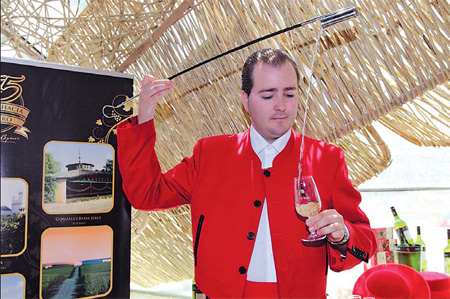Venenciador Alejandro Benitez Ruiz demonstrates his skill of serving sherry straight from a barrel at the Spain Pavilion's Pedro Larumbe restaurant. Suited in a red and black, he thrusts a venencia - a cup attached to a long handle - into a small hole in the barrel, lifts it above his head, and pours the sherry into a small glass below.

Venenciador Alejandro Benitez Ruiz. gao erqiang / china daily |
After this spectacular performance, wine lovers get to sip on an expertly and flamboyantly served glass of sherry.
"The venencia is traditionally made of silver and fastened to a long handle made from whalebone. The person who works the venencia is called a venenciador. It is an age-old profession and its practitioners are often seen at festivals and other celebrations in Spain," said Ruiz, 28, who has been practicing this traditional form of sherry pouring for more than 12 years.
"The work of the venenciador has been even found illustrated on ancient Greek pottery, dating back to 3 BC. Although we no longer use whalebone and have replaced silver with stainless steel, it is still an indispensable part of my hometown's wine culture," he said.
Ruiz is from Jerez de la Frontera in the so-called "sherry triangle" in southern Spain. He comes from a family with a long history of working with wines in Jerez de la Frontera, dating back to his grandfathers, and along with his father and uncles. "My family and I have held every position available in a winery, including grape farmers, sommelier, venenciador and more," said Ruiz. "And I still have a real venecia made of whalebone at home."
Ruiz started to practice this sherry-pouring technique at 16. "I used water to practice, of course, otherwise it would have been a waste of good wine," he said. As his skills progressed, he began practicing the technique with wine and then in front of audiences.
Ruiz said he wants to continue his profession by showcasing his expertise at the Expo Garden. "We're here for those who like their sherry straight from the wooden barrel. Sampling the wine directly does not only shows its characteristics but also allows for a better aroma by its mixing with air," he said.
Ruiz is surprised by the amount of Chinese's wine consumption at the Expo Garden. He pours around 400 to 500 glasses a day "What I didn't expect was that people would ask for seconds and they're especially interested in the red hat that I wear," he said. "Most customers ask for photographs with me wearing the hat."
With this ancient profession revived at the Expo, Ruiz is even more excited than the visitors he entertains. "Not many people are doing this in Spain, but it's a well-respected job and I'm happy to see it attracts so many people in China."

